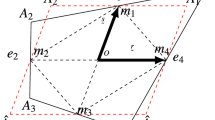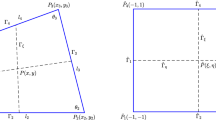Abstract
In this paper, we construct a new nonconforming quadrilateral element with 12 degrees of freedom to solve the biharmonic problems. \({\mathscr {T}}_{h}\) is a triangulated quadrangulation of the domain \(\varOmega \). For a quadrilateral element \(Q_{T}\), the finite element space, which contains \({\mathbb {P}}_{3}(Q_{T})\), is a subspace of the bivariate spline space \({\mathbf {S}}_{3}^{1}(Q_{T})\). The degrees of freedom are chosen as the four point values, the four edge integrals of the shape functions and the edge integrals of their normal derivatives such that the weak continuity between elements can be satisfied. Accordingly, we explicitly establish 12 spline interpolation bases in the B-net form. Error estimates are given with optimal convergence order in both discrete \(H^{2}\) and \(H^{1}\) seminorms. The proposed element NCQS12 can get the superconvergence results with theoretical proof when \({\mathscr {T}}_{h}\) is an uniform parallelogram mesh. Some degenerate meshes are considered subsequently. Finally, we do some numerical experiments to verify the theoretical analysis. Numerical results show that the proposed element performs well over the asymptotically regular parallelogram meshes, which is same as over the uniform parallelogram meshes.











Similar content being viewed by others
References
Adini A, Clough R (1960) Analysis of plate bending by the finite element method. University of California, California
Argyris J, Fried I, Scharpf D (1968) The TUBA family of plate elements for the matrix displacement method. Aeronaut J 72(692):701–709
Batoz JL, Tahar MB (1982) Evaluation of a new quadrilateral thin plate bending element. Int J Numer Methods Eng 18(11):1655–1677
Bell K (1969) A refined triangular plate bending finite element. Int J Numer Methods Eng 1(1):101–122
Bogner F, Fox R, Schmit L (1965) The generation of interelement compatible stiffness and mass matrices by the use of interpolation formulae. In: Przemieniecki J (ed) Proceedings of the conference on matrix methods in structural mechanics, pp 397–444. Wright Patterson Air Force Base, Ohio
Chen S (1996) 12-parameter rectangular plate elements ith geometric symmetry. Numer Math A J Chin Univ 3:233–238 (In Chinese)
Chen J, Li C (2013) Development of quadrilateral spline thin plate elements using the B-net method. Acta Mech Sin 29(4):567–574
Chen J, Li C (2015) The cubic spline Hermite interpolation bases for thin plate bending quadrilateral elements. Sci Sin 45(9):1523
Chen J, Li CJ, Chen WJ (2010) A family of spline finite elements. Comput Struct 88(11–12):718–727
Chen S, Shi D, I chiro H (2003) Trapezoidal plate blending element with double set parameters. J Comput Math 21(4):513–518
Che W, Cheung YK (1997) Refined quadrilateral discrete Kirchhoff thin plate bending element. Int J Numer Methods Eng 40(21):3937–3953
Chen X, Cen S, Long Y (2005) Two thin plate elements developed by assuming rotations and using quadrilateral area coordinates. Eng Mech 22(4):1–5,30
Clough R, Tocher J (1965) Finite element stiffness matrices for analysis of plates in bending. In: Proceedings of the 1st conference on matrix methods in structural mechanics. Wright Patterson AFB, Ohio
Farin G (1986) Triangular Bernstein–Bézier patches. Comput Aided Geom Des 3(2):83–127
Ciarlet PG (1978) The finite element method for elliptic problems, vol 4. North-Holland, Amsterdam
Grisvard P (1985) Elliptic problems in nonsmooth domains. Pitman Advanced Publishing Program, Boston
Hrabok M, Hrudey T (1984) A review and catalogue of plate bending finite elements. Comput Struct 19(3):479–495
Jeyachandrabose C, Kirkhope J, Meekisho L (1987) An improved discrete Kirchhoff quadrilateral thin-plate bending element. Int J Numer Methods Eng 24(3):635–654
Lascaux P, Lesaint P (1975) Some nonconforming finite elements for the plate bending problem. Revue française d’automatique, informatique, recherche opérationnelle. Anal Numér 9(R1):9–53
Li C, Wang R (2006) A new 8-node quadrilateral spline finite element. J Comput Appl Math 195(1):54–65
Ming P, Shi Z (2002) Quadrilateral mesh. Chin Ann Math B 23(2):235–252
Park C, Sheen D (2013) A quadrilateral Morley element for biharmonic equations. Numer Math 124(2):395–413
Sander G (1964) Bornes supérieures et inférieures dans l’analyse matricielle des plaques en flexion–torsion. Bull Soc R Sci Liège 33:456–494 (In French)
Shi Z (1984) A convergence condition for the quadrilateral Wilson element. Numer Math 44(3):349–361
Shi Z (1986) On the convergence of the incomplete biquadratic nonconforming plate element. Math Numer Sin 8(8):53–62 (In Chinese)
Shi Z (1990a) On the accuracy of the quasi-conforming and generalized conforming finite elements. Chin Ann Math 11(2):148–155
Shi Z (1990b) On the error estimates of Morley element. Math Numer Sin 12(2):113–118
Shi Z, Wang M (1988) Finite element methods. Science Press, Beijing
Soh AK, Long Z, Cen S (2000) Development of a new quadrilateral thin plate element using area coordinates. Comput Methods Appl Mech Eng 190(8–10):979–987
Suire G, Cederbaum G (1995) Periodic and chaotic behavior of viscoelastic nonlinear (elastica) bars under harmonic excitations. Int J Mech Sci 37(7):753–772
Veubeke BFD (1968) A conforming finite element for plate bending. Int J Solids Struct 4(1):95–108
Wang RH (1975) The structural characterization and interpolation for multivariate splines. Acta Math Sin 18(2):91–106 (In Chinese)
Wang RH (2001) Multivariate spline functions and their applications. Science Press, Beijing
Zhao Z, Xiao L, Chen S (2012) 13-parameter quadrilateral plate blending element with double set parameters. Math Numer Sin 34(3):285–296 (In Chinese)
Author information
Authors and Affiliations
Corresponding author
Additional information
Communicated by Philippe Heluy.
Publisher's Note
Springer Nature remains neutral with regard to jurisdictional claims in published maps and institutional affiliations.
This work was supported by the National Natural Science Foundation of China (nos. 11572081, 11871137, 11471066).
Rights and permissions
About this article
Cite this article
Li, CJ., Jia, YM. A superconvergent nonconforming quadrilateral spline element for biharmonic equation using the B-net method. Comp. Appl. Math. 39, 70 (2020). https://doi.org/10.1007/s40314-020-1105-0
Received:
Revised:
Accepted:
Published:
DOI: https://doi.org/10.1007/s40314-020-1105-0




